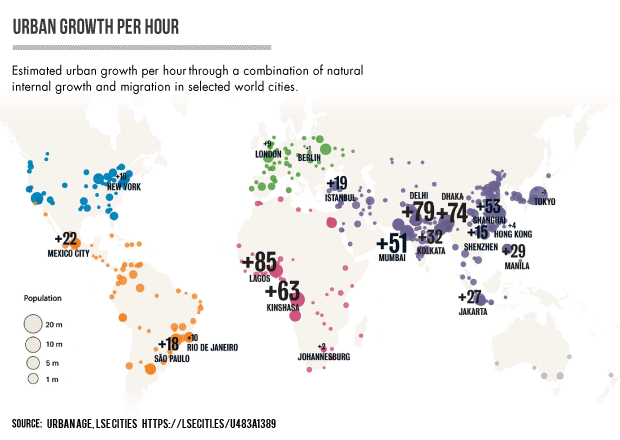![]() 5 minute read
5 minute read
The rapid urbanisation challenges the air quality in the cities. Are there ways to maintain the acceptable air quality levels and reduce the air pollution using the technology and smart urban planning?
Economic and
health burden
Urban areas will host up to 70% of world’s population by 2050 shaping the mega-cities. To give an example, by UN predictions, the fishing village of Shenzhen in south-east China, which had 3 thousand inhabitants in the middle of the 20th century will exceed 12 million already in 2025. Besides this statistic lie significant regional differences in demographic, economic and environmental change. It is essential to analyse the possible future scenarios of urban development taking the environmental settings as the main characteristic.

Smog in the New Delhi and Mexico City is the evidence of what happens when cities are not prepared and not designed for rapid population growth. Urban air pollution is responsible for mortality and morbidity, mainly from respiratory and cardiovascular diseases. The World Health Organisation has estimated that in 2012 ambient air pollution took away 2.7 million lives. There is some epidemiologic data supporting the fact of connection between ambient air pollution and health issues leading to fatal outcomes. Health economists worldwide aim to quantify the costs of air pollution or the benefits of its reduction. The Aphekom project evaluated the health and monetary benefits of reducing the exposure to a particular matter (long and short-term) and ozone in 25 European cities. The air pollution in most of the cities exceeded the World Health Organisation guidelines. Researchers have estimated[nbsp]that complying with the establishes WFO’s directions the monetary gain would be €31 billion yearly, including savings on healthcare, social and society costs, like life expectancy and quality of life.
Another research[nbsp]by Richard York and Eugene A. RosaReviewed underlines the importance of the smart urban planning. The results of the study suggest that demographic factors like number and size of households impact on the level of air pollution. The population is clearly an important factor in environmental impact, however, its distribution across households matters. Moreover, the effect of household growth patterns on the absolute quantity of pollution emissions depends on the level of affluence in nations where growth occurs.
Taking the UN predictions and results of the researches into consideration, how to reduce the air pollution level in the rapidly developing and growing cities? Using the smart urban planning and latest technologies like Internet of Things and Big Data analysis.
Empowering the
citizens
Refreshing the air in mega-populated cities requires decreasing the transport dependence for the citizens as well as greening urban territories. Tall buildings on the narrow streets provide no air ventilation harming the people who live there as well as people who commute within these streets. If we want less traffic and more cyclists on the roads, should not we think of which air do they inhale? Moreover, the city has to be planned the way that the places of interests can be reached via walking/bicycling range and convenient public transport connection. Future of car and cycling transportation in the eco-city has the positive development scenario, read more on the future of transportation here.
There are many different ways to measure the air pollution. The measurement sensors are costly to implement. However, the technologies become smaller and more accessible. The new trend that the world is experiencing is the crowdsourcing the air quality data. The Citizen Sense project[nbsp]is funded through a European Research Council (ERC) Starting Grant will answer the question what happens when citizens receive the information on air quality and whether it will trigger more responsible behaviour. Air Quality Egg was one of the first personal sensors and nowadays there is a network of 1080 registered sensors thanks to Citizen Sense. All the data is available to see online. But Egg is not the only crowdsourcing data device. The[nbsp]Smart Citizen Sensor[nbsp]collects the data on air composition, temperature, light intensity, sound levels and humidity at the same time. And will be more ways for citizens to collect and analyse their behaviour in the future.
In Amsterdam, the TrafficLink in cooperation with government authorities and urban labs are designing the app for lorry drivers. Combining different types of data, like traffic, air and noise pollution, free parking spaces, the application will provide lorry drivers with a unique ‘time slot’ and parking space in the city, combined with expected travel time, based on real-time traffic information. This enables them to drive directly to the available space, thus reducing CO2- and nitrogen emissions and waiting time. What if later to implement the same technology for the regular drivers and give them an opportunity to choose the less polluted road?
Air pollution
on your neck
The problem of air pollution is recognised by designers as well. Now you can see, touch and feel the burden air pollution brings to the human body. Using the air quality data from Sheffield, UK, Stefanie Posavec together with Miriam Quick has visualised the air.

Touching Air has three necklaces made of perspex segments of different textures. Each of them represents the week worth of data, envisioning the harm air brings to one’s heart, lungs. You can feel how the air quality in Sheffield went up and down during the week. Some parts look pretty hurtful, so why won’t we do something about it?




